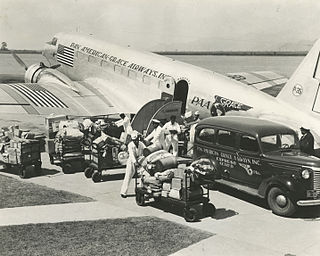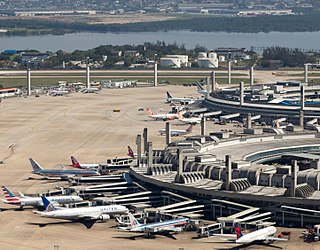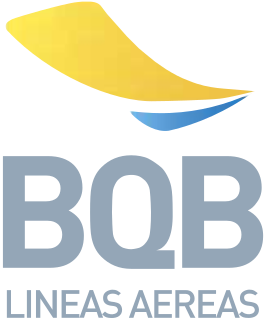
Pan American World Airways, originally founded as Pan American Airways and commonly known as Pan Am, was the principal and largest international air carrier and unofficial overseas flag carrier of the United States for much of the 20th century. It was the first airline to fly worldwide and pioneered numerous innovations of the modern airline industry, such as jet aircraft, jumbo jets, and computerized reservation systems. Until its dissolution in 1991, Pan Am "epitomized the luxury and glamour of intercontinental travel", and it remains a cultural icon of the 20th century, identified by its blue globe logo, the use of the word "Clipper" in its aircraft names and call signs, and the white uniform caps of its pilots.

Juan Terry Trippe was an American commercial aviation pioneer, entrepreneur and the founder of Pan American World Airways, one of the iconic airlines of the 20th century. He was involved in the development and production of the Boeing 314 Clipper, which opened trans-Pacific airline travel, the Boeing Stratoliner which helped to pioneer cabin pressurization, the Boeing 707 and the Boeing 747 which introduced the era of jumbo jets. Trippe's signing of the 747 contract coincided with the 50th anniversary of Boeing.
LATAM Airlines Chile is an airline based in Santiago, Chile, and is one of the founders of LATAM Airlines Group, Latin America's largest airline holding company. The main hub is Comodoro Arturo Merino Benítez International Airport (Santiago), with secondary hubs in El Dorado (Bogotá), Jorge Chávez (Lima), Mariscal Sucre (Quito), and José Joaquín de Olmedo (Guayaquil) airports.

Pan American-Grace Airways, also known as Panagra, and dubbed "The World's Friendliest Airline" was an airline formed as a joint venture between Pan American World Airways and Grace Shipping Company. On September 13, 1928, a small single-engine Fairchild airliner flew from Lima, Peru, to Talara, Peru, which marked not only the beginning of Pan American Grace Airways but also the inauguration of scheduled air transportation along the West Coast of South America. From this short flight in 1928 to nonstop flights from New York to South America with Douglas DC-8 Intercontinental Jets in 1966, Panagra became the standard-bearer for transportation between the US Mainland East Coast and the West Coast of South America for 39 years. The "World's Friendliest Airline" merged with Braniff International Airways in 1967, and the combined carrier became the largest US airline serving South America.

Rio de Janeiro/Galeão – Antonio Carlos Jobim International Airport, popularly known by its original name Galeão International Airport, is the main airport serving Rio de Janeiro, Brazil. In 2019, it was the country's fourth-busiest airport by passenger traffic. It is named after the neighborhood of Galeão. Praia do Galeão is located in front of the original passenger terminal and where in 1663 the galleon Padre Eterno was built; and since 5 January 1999 also after the Brazilian musician Antonio Carlos Jobim. Galeão Airport is explicitly mentioned in his composition Samba do avião. It is the largest airport site in terms of area in Brazil.

Santos Dumont Airport is the second major airport serving Rio de Janeiro, Brazil. It is named after the Brazilian aviation pioneer Alberto Santos Dumont (1873–1932). It is operated by Infraero.
SAETA was a privately held airline of Ecuador, which was founded in 1960. During its heyday in the 1990s, it flew to numerous destinations in North and South America from its base in Guayaquil. The collapse of Ecuador's economy in the late 1990s forced this airline to cease operations in February 2000.

The Consolidated Commodore was an American flying boat built by Consolidated Aircraft and used for passenger travel in the 1930s, mostly in the Caribbean, operated by companies like Pan American Airways.

Pan American World Airways Flight 202 was a Boeing 377 Stratocruiser aircraft that crashed in the Amazon Basin about 281 nautical miles (520 km) southwest of Carolina, Brazil on April 29, 1952. The accident happened en route from Rio de Janeiro, Brazil, to Port of Spain, Trinidad and Tobago, during the third leg of a four-leg journey. All 50 people on board were killed in the deadliest-ever accident involving the Boeing 377.

Panair do Brasil was an airline of Brazil. Between 1945 and 1965 it was considered to be the largest carrier not only in Brazil but in all of Latin America. It ceased operations in 1965.

Ralph Ambrose O'Neill was a flying ace from World War I credited with 103 combat patrols and five aerial victories. He was the first "Chief" Commander of the modern Mexican Air Force. He was also a pioneer of commercial aviation.

Serviços Aéreos Cruzeiro do Sul was the second oldest airline of Brazil, tracing its origins to 1927, when it was founded as Syndicato Condor, a subsidiary of Deutsche Luft Hansa. Syndicato Condor retained rights and interests of a former German trade company, Condor Syndikat, which previously operated passenger and mail services in Brazil. It was renamed Cruzeiro do Sul in 1943. In 1975, Varig, a Brazilian airline which shared very similar origins, acquired its controlling shares. In 1993, it was finally merged into Varig.
RealTransportes Aéreos was a Brazilian airline founded in 1945. It was merged into Varig in 1961, when Varig bought the Consórcio Real-Aerovias-Nacional, of which Real was the main carrier.
Empresa de Transporte Aéreo & Companhia Limitada (ETA) was a Brazilian airline founded in 1928. It ceased operations in 1929.
Empresa de Transportes Aéreos Aerovias Brasil S/A was a Brazilian airline founded in 1942. It was merged into Varig in 1961, when Varig bought the Consórcio Real-Aerovias-Nacional, of which Aerovias Brasil was one of the partners.
Transportes Aéreos Nacional was a Brazilian airline founded in 1946. It was merged into Varig in 1961, when Varig bought the Consórcio Real-Aerovias-Nacional, of which Transportes Aéreos Nacional was one of the partners.
Condor Syndikat was a German trade company, with headquarters in Berlin, that operated airline services in Brazil while also providing aircraft, maintenance and aviation information. It is also the parent company of the Brazilian airlines Varig and Syndicato Condor, which later became Serviços Aéreos Cruzeiro do Sul. They were the two oldest airlines in Brazil.

Jacarepaguá–Roberto Marinho Airport is an airport in the neighborhood of Barra da Tijuca, Rio de Janeiro, Brazil dedicated to general aviation. Following extensive renovation in 2008 the airport was renamed after Roberto Pisani Marinho (1904–2003), a journalist and former president of Globo Network. It is a major helibase for offshore support.

BQB - Líneas Aéreas was an airline based in Montevideo, Uruguay. Its main base was Carrasco International Airport. The airline was owned by the owner of Buquebus, Juan Carlos López Mena. The airline, which was considered the unofficial flag carrier of Uruguay, ceased operations in April 2015, after a crisis that began in 2014.
The airline Aviación del Litoral Fluvial Argentino or A.L.F.A. was a joint venture established on May 16, 1946, by the Argentine government, through national decree 13.532, and the merger of "Corporación Sudamericana de Servicios Aéreos S.A." (CSSA) and "Compañía Argentina de Aeronavegación Dodero S.A." (CAAD). The airline flew to the Argentine coast, as well as reaching Asunción, Paraguay and Montevideo, operating with Short Sandringham and Sunderland flying boats. In May 1949 it merged with other companies existing at the time, FAMA, ZONDA, and Aeroposta, to create Aerolíneas Argentinas.












